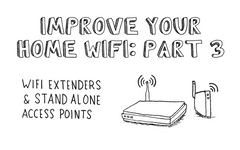Payment methods accepted

Into the Great Outdoors: Running Ethernet Cable Outside
Occasionally, it's necessary to use exterior Ethernet cable (CMX) to run an Ethernet cable outside. These are the common scenarios:
- Outdoor Wi-Fi access points
- To connect two or more distinct structures
- Outdoor IP based (Internet Protocol) surveillance cameras
Depending on the environment, it may make more sense to bury the outdoor Ethernet cable as opposed to open air runs. Whether open-air or buried into the ground, running Ethernet cables outside requires very particular cable selection. First, CMX rated Ethernet cable is the only appropriate cable to use outdoors. Life, not being that simple, means there are various types of CMX rated Ethernet cable. The only commonality between them is they have a UV resistant outer cable jacket, either PVC (Polyvinyl Chloride) or the far superior LLDPE (Linear Low Density Polyethylene). Regular Ethernet cable meant for indoor use will quickly degrade in the sun, wind, rain and temperature swings.
Direct Burial vs. Standard Outdoor Ethernet Cable
There are two major types of CMX cable:
- Direct burial rated (underground Ethernet cable)
- And, well, NOT direct burial rated (standard outdoor)
Standard outdoor rated Ethernet has the same outer UV resistance jacket as the direct burial variety, but is otherwise very similar to equivalent indoor Ethernet cable types.
Direct burial rated has additional water resistant features built in. Typically the additional water resistance is via petroleum gel, dry water block tape, dual jackets, or a combination of all three. Direct bury Ethernet cable is designed to withstand burial into the ground, either directly or inside conduit, but may be used above ground too. trueCABLE utilizes either petroleum based gel filling or the dry water block tape. Of the two, the petroleum based gel filling is the superior option as the gel is not water soluble and is impervious to moisture infiltration. The downside to petroleum gel filling is the gel is sticky and a bit messy to deal with. The downside to dry water block tape is reduced resistance to moisture, and it tends to make the cable thicker overall.
![]()
Shielded vs. Unshielded Outdoor Ethernet Cable
A question that often comes up is “should I use only shielded cable outside”? The short answer is no. The longer answer is “it depends on the environment”. The purpose of cable shielding is to ward off EMI/RFI or ESD. The shielding, usually in the form of foil referred to as FTP (Foil Twisted Pair), will be accompanied by a ESD ground/drain wire as well. Generally, I recommend using unshielded cabling unless there is a valid need for shielded, such as when burying the cable within 8” of electrical wire on parallel runs. The other primary reason to use shielded is for ESD (Electrostatic Discharge) drain off such as when running outdoor Ethernet cable above ground in structure-to-structure scenarios. ESD build up occurs with dry air movement across cabling, and could ruin your network equipment if not allowed to discharge to ground.
If you need to use shielded Ethernet cable then by all means install it but be aware that shielded cable carries penalties with it, such as:
- Increased costs for the cable and especially termination hardware
- Significantly decreased flexibility
- Significantly higher effort required for terminations
As an example of thick shielded direct burial Ethernet cable, let’s talk about the construction of trueCABLE’s Cat6A Direct Burial Ethernet Cable Shielded. At its core, this cable functions like any other Cat6A Ethernet cable. It has eight wires twisted into four pairs and is terminated to the TIA 568 A or B color code standard. Termination should be to a shielded Cat6A patch panel or shielded Cat6A keystone jack. Proper electrical grounding must be at the patch panel or switch end of the run. Due to the thickness of this cable shielded RJ45 plugs can be used, but this is not advised. If you need a male plug at the end of the cable then consider our Cat6A Field Term Plug Shielded instead.
A picture helps…

Given the potential pitfalls of shielded cable, it is a good idea to carefully consider your environment. trueCABLE carries a number of CMX rated Ethernet cable types, and further information around selection is found in Selecting the Correct Outdoor Ethernet Cable.
Dealing with Direct-Burial Scenarios
First… STOP! Before digging, it is vital that you contact all local utilities and have a representative come to the property and mark any buried gas lines, water lines, etc. You won’t be charged for this service as the utility company is more than happy to help avoid a major incident that could cause loss of service or even life.
Is conduit better for direct burial?
A common question we get is “Is it better to use conduit underground”? Since direct burial Ethernet cable is rated for direct burial you may indeed bury it without conduit. In fact, based upon my experience, direct burial is actually superior to putting it into a conduit as conduit will allow water in over time (especially PVC). If you live in an area that has a frost line only 3” down, then simply bury the cable without conduit at least 10” down to avoid mechanical damage from shovels and the like. For areas that have frost lines measured in feet, freeze/thaw cycles can play havoc with PVC conduit. Consider that a conduit full of water will have nowhere to go when it freezes and potentially ruin your underground run. The best bet in this scenario is to directly bury Ethernet cable 18 to 24 inches down bedded on top of a couple inches of pea gravel to help with water drainage. Further, it is a good idea to leave some “lazy” curves in the run to allow for ground movement.
If you are determined to use conduit, IMC metal conduit will be more durable, but costly. IMC metal conduit is used for plumbing and has threads that can be thoroughly sealed. It is wise to pull twine/string through the conduit with the cable and leave it in place to make cable replacements easier.
When installing Ethernet cable in PVC or IMC conduit:
- Use synthetic cable lubricant and plenty of it
- This is, at a minimum, a two person job. One person should be on the feed end and the other at the pull point. The person on the feed end should watch out for kinks and protect the cable as it enters the conduit. Some installations require multiple pull points and potentially more than two people. Never attempt to pull more than 100 feet of Ethernet through the same continuous section of conduit and have no more than two 90 degree bends in any 100 foot section of conduit. It is very easy to pull too hard as more conduit equals more friction on the cable jacket.
- Minimum trade size recommended is ¾”, and the actual trade size of the conduct you should use is based on the load ratio. See Conduit Fill Chart for Ethernet and Coaxial Cable.
To make digging a trench more efficient, a trencher machine can be rented from the local equipment rental store. Sure, a shovel can be used but it will result in far more mess, take longer and result in a less consistent trench. In the event operating the trencher is beyond your comfort zone, then hire a local handy person with experience. Eye and ear protection are important.
Dealing with Above-Ground Scenarios
For installations that happen to run outdoors, but do not span between structures, you are in luck. Unless there is a known EMI risk posed by electrical cable, simply use unshielded standard outdoor CMX Ethernet cable. Attach the cable to your structure with screw-in outdoor grade RG6 coaxial cable clamps. These clamps are easily picked up at Home Depot or Lowes. If there is more than one cable running together, bundle the cables with hook and loop straps every 3 to 5 feet. DO NOT use nylon ties (commonly known as zip ties). Nylon ties focus excessive pressure in a small area that will cause long term degradation to your transmission performance.
For installations above ground and between two structures, you will need to use shielded Ethernet cable with a messenger built-in or have a pre-installed messenger. A messenger is a high tensile strength steel wire that has been lashed to two or more points. For more on how to actually install messenger wire cable, or a separate messenger, see Cat6 Shielded Aerial Messenger Cable: Up The Ladder You Go!
Ethernet cable that is installed outdoors and exposed to ambient air temperature will require careful length consideration. As temperatures rise, the permitted lengths get shorter. Copper operates less efficiently at higher temperatures, a situation referred to as attenuation (signal degradation). How long can your cable be outdoors? Good question, and that is answered in Temperature's Effect on Ethernet Cable Length.
Mitigating Extreme ESD (Lightning)
Are you at risk for a lightning strike? Technically speaking, we all are. Just ask the poor golfer who chose to golf at the wrong time…. yikes!
On a more serious note, some regions are significantly more affected by frequent lightning strikes than others. Using the Internet, find out if your area is in a high risk zone. If so, then any outdoor Ethernet cable is at risk whether above ground or buried. Generally, Ethernet cable that is not buried and does not span structures is at lower risk for lightning strikes, so this is less of an issue. A great example of this type of installation is Ethernet cable used for IP surveillance cameras that are all attached to the same structure. That said, it does not hurt to use ESD protection regardless. Better safe than sorry.
A rather detailed and extensive blog with installation examples and recommended hardware is found in When Lightning Strikes! Ethernet Data Cable and Lightning Protection.
Tips
- According to the NEC (National Electric Code) section 800.113, since CMX Ethernet cable is not fire rated it must not run indoors more than 50 feet before termination in any commercial structure. For residential single family and duplex dwellings, CMX Ethernet cable is permitted to be used as indoor/outdoor cable without restriction with the caveat that it cannot exceed 0.25” thickness (OD or outer diameter). This makes our Cat6 Outdoor Ethernet Cable Unshielded the perfect residential indoor/outdoor solution when not direct burying and shielding is not required.
- If you have an underground rodent problem in your area (moles) your buried Ethernet cable is at risk. It is advisable to use conduit in this circumstance, and preferably metal conduit. The costs are higher, but the benefit is the conduit need not be buried as deeply.
- If you’re running shielded Ethernet cable outside between two buildings (buried or not), it is very important to avoid what is known as a ground loop. This situation arises when the building electrical mains have different ground potentials. This can result in voltage injection through the cable if the cable is running to ground at both ends through the different AC grounds. Mitigation strategies can be found in How to Fix a Ground Loop.
-
Balance performance with usability. Shielded and especially shielded direct burial Ethernet cable is quite thick. If your installation involves wiring up outdoor WiFi access points or IP surveillance cameras the water resistant housings of these devices may be too small/tight for the thicker varieties of cable. Cat6A shielded direct burial cable sounds great until you find yourself in a situation where you cannot physically install it! Give serious consideration to Cat5e outdoor unshielded or even shielded (when necessary) to make for a much easier installation. Often, these devices do not require any speed above 1 Gigabit. Remember, Cat5e still supports 2.5GBASE-T (2.5 Gbp/s) and also supports 100W DC PoE.
So, there you have it! A comprehensive explanation of how to deal with outdoor Ethernet cable installation. One of the most rewarding aspects of running Ethernet cable outside is seeing it all come together, but understanding the ins and outs of outdoor Ethernet cable requires planning and research. With that I will say…
Happy networking!
trueCABLE presents the information on our website, including the “Cable Academy” blog and live chat support, as a service to our customers and other visitors to our website subject to our website terms and conditions. While the information on this website is about data networking and electrical issues, it is not professional advice and any reliance on such material is at your own risk.


































I have to run an outside cable from the router to the access gate that is 660 ft away